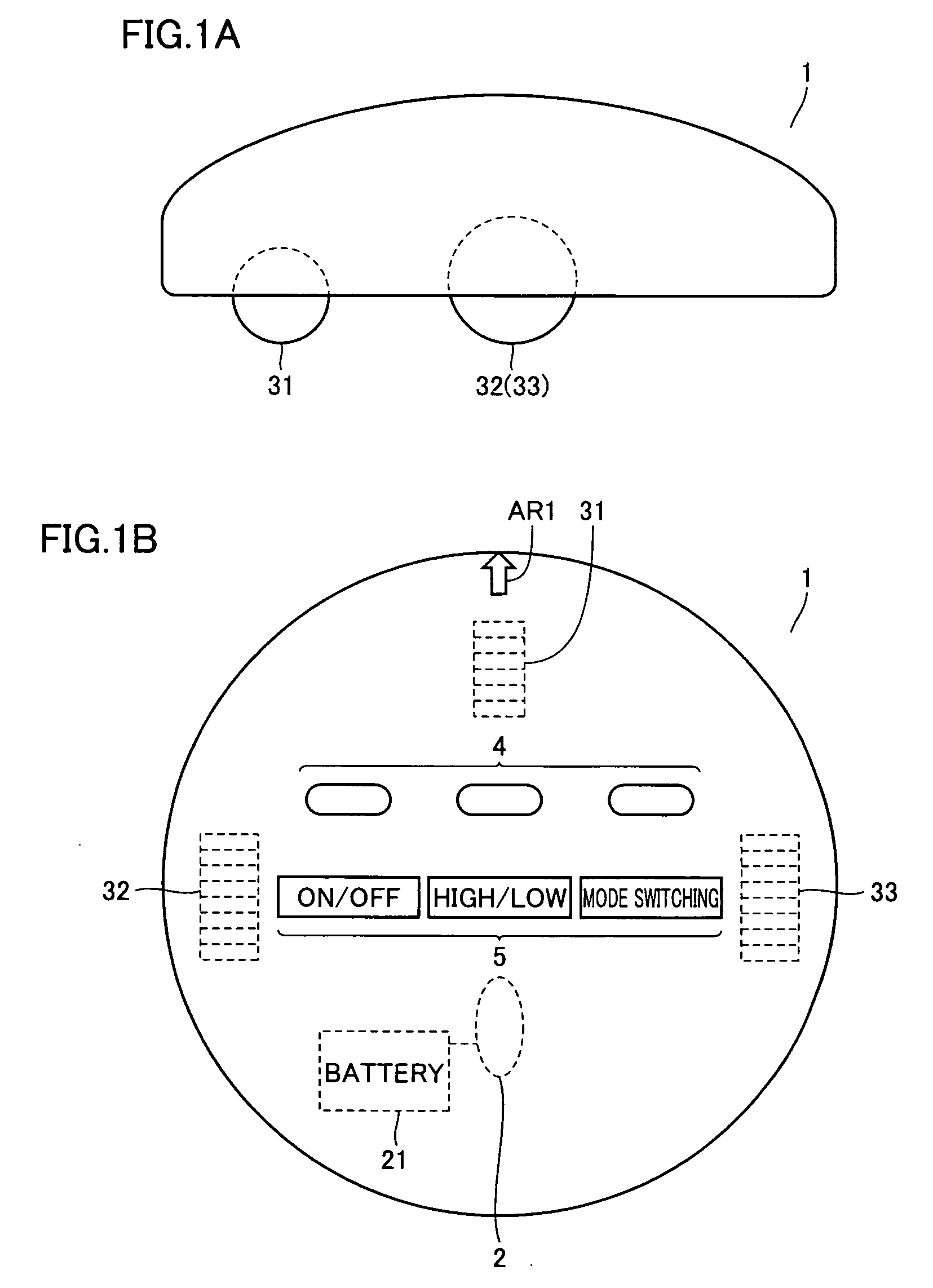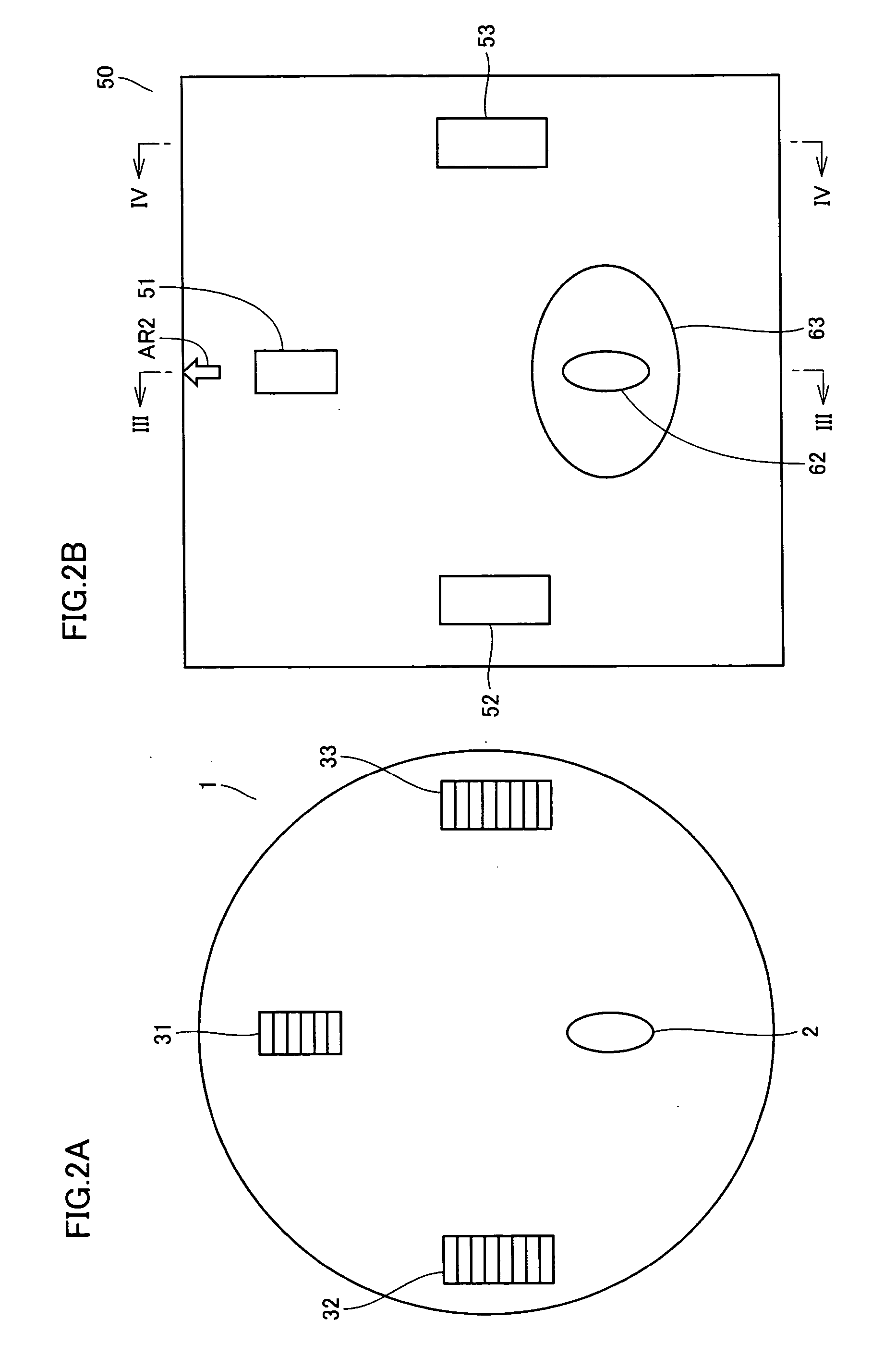Electric device having charging function
a technology of electric devices and functions, applied in secondary cells, electrographic processes, instruments, etc., can solve problems such as heating, increase costs, user forgetting to arrange the cover, etc., and achieve the effect of preventing a factor affecting energy transmission
- Summary
- Abstract
- Description
- Claims
- Application Information
AI Technical Summary
Benefits of technology
Problems solved by technology
Method used
Image
Examples
first embodiment
[0034]FIG. 1A shows an outer appearance of a side surface of a mobile work robot 1, and FIG. 1B shows an outer appearance of a top surface of mobile work robot 1. Referring to FIGS. 1A and 1B, mobile work robot 1 includes a front wheel 31 and rear wheels 32 and 33, which are in contact with a floor surface, and is driven to rotate for movement, as well as a LED (Light Emitting Diode) unit 4 arranged on the top surface of a casing of mobile work robot 1 for notifying of an operation mode by light, and a switch unit 5 for manual operation by a user. The casing of mobile work robot 1 is provided at its surface opposed to the floor surface with a charging terminal 2, which is exposed for non-contact charging. The casing of mobile work robot 1 is provided at its top surface with a mark AR1, which is used for positioning when mobile work robot 1 is to be placed on charging unit 1 as will be described later. The operation modes, which are notified by LED unit 4, include an operating mode, ...
second embodiment
[0046] In FIG. 6, the electrode surface of charging terminal 62 is fixed substantially at the same vertical position or level as the bottom surface of concavity 63, and the electrode surface of charging terminal 2 of mobile work robot 1 projects from the bottom surface of mobile work robot 1 to an extent not impeding the movement. However, a reverse structure may be employed provided that the foregoing gap of the predetermined distance can be kept. The example will now be described with reference to FIGS. 5 and 7 to 10.
[0047]FIG. 5 shows a charging terminal 621, which is employed in place of charging terminal 62 in FIG. 3, and has an electrode surface 625. FIG. 10 shows a state, in which mobile work robot 1 is placed on charging unit 50. In FIG. 10, mobile work robot 1 has a charging terminal 622 in place of charging terminal 2. In a normal state, electrode surface 625 of charging terminal 621 of charging unit 50 is located at the same level are the bottom surface (concave surface)...
third embodiment
[0053] The foregoing structures use concavity 63 for forming the gap, which is used for the charging, and for protecting the electrode from damage. Instead of concavity 63, a nonconductive member 630 (e.g., a rubber wall) hatched in FIGS. 11 and 12 may be arranged to surround a charging terminal 631. Nonconductive member 630 has a ring-like form surrounding charging terminal 631, and is fixed to the top surface of charging unit 50. Since charging terminal 631 is always surrounded by nonconductive member 630, it is possible to prevent damage due to contact with another member. A height of the ring of nonconductive member 630 from the top surface of charging unit 50 is merely required to allow such a state that nonconductive member 630 substantially cuts off the space (gap), which is formed between charging terminal 632 of mobile work robot 1 and charging terminal 631 for magnetic flux transmission, from its external side in the charging operation. Since ring-like nonconductive member...
PUM
| Property | Measurement | Unit |
|---|---|---|
| energy | aaaaa | aaaaa |
| weight | aaaaa | aaaaa |
| power | aaaaa | aaaaa |
Abstract
Description
Claims
Application Information
 Login to View More
Login to View More - R&D
- Intellectual Property
- Life Sciences
- Materials
- Tech Scout
- Unparalleled Data Quality
- Higher Quality Content
- 60% Fewer Hallucinations
Browse by: Latest US Patents, China's latest patents, Technical Efficacy Thesaurus, Application Domain, Technology Topic, Popular Technical Reports.
© 2025 PatSnap. All rights reserved.Legal|Privacy policy|Modern Slavery Act Transparency Statement|Sitemap|About US| Contact US: help@patsnap.com



